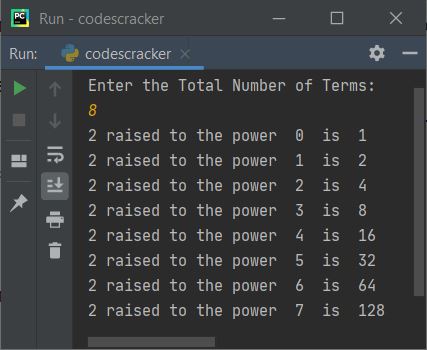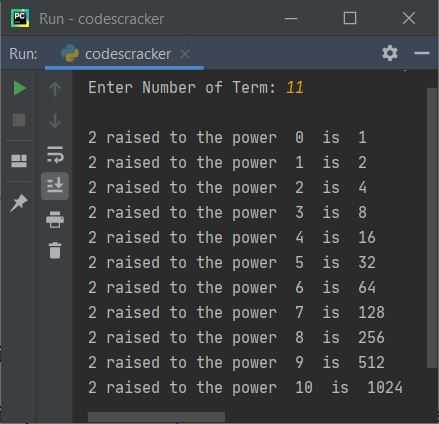- Python Basic Programs
- Python Program Examples
- Python Print Hello World
- Python Get Input from User
- Python Add Two Numbers
- Add Subtract Multiply Divide
- Python Check Even or Odd
- Python Check Prime or Not
- Python Check Alphabet or Not
- Python Check Vowel or Not
- Python Check Leap Year or Not
- Check Reverse equal Original
- Check Positive Negative Zero
- Python Check Armstrong or Not
- Python Check Palindrome or Not
- Python Check Perfect Number
- Python Find Reverse of Number
- Python Count Digits in Number
- Python Add Digits of Number
- Sum of First and Last Digits
- Python Product of Mid Digits
- Sum of Squares of Digits
- Interchange Digits of Number
- Python Sum of n Numbers
- Python Print ASCII Values
- Python Swap Two Numbers
- Python Swap Two Variables
- Python Fahrenheit to Celsius
- Python Celsius to Fahrenheit
- Python Display Calendar
- Python Days into Years, Weeks
- Find Largest of Two Number
- Find Largest of Three Number
- Python Print Fibonacci Series
- Generate Armstrong Numbers
- Python Make Simple Calculator
- Python Add Binary Numbers
- Binary Number Multiplication
- Python Mathematical Programs
- Find Sum of Natural Numbers
- Find Average of n Numbers
- Python Print Multiplication Table
- Print Table using Recursion
- Python Find Average Percentage
- Python Find Grade of Student
- Find Square Root of Number
- Python Print Prime Numbers
- Find Numbers Divisible by
- Python Find Factors of Number
- Python Find Factorial of a Number
- Python Find HCF & LCM
- Python Kilometres to Miles
- Python Find Area of Square
- Python Find Area of Rectangle
- Python Find Area of Triangle
- Python Find Area of Circle
- Python Find Perimeter of Square
- Find Perimeter of Rectangle
- Python Find Perimeter of Triangle
- Find Circumference of Circle
- Python Simple Interest
- Python Solve Quadratic Equation
- Python Different Set of Operations
- Python Display Powers of 2
- Python Find nCr & nPr
- Python Pattern Programs
- Python Print Pattern Programs
- Python Print Diamond Pattern
- Python Print Floyd's Triangle
- Python Print Pascal's Triangle
- Python List Programs
- Python Count Even/Odd in List
- Python Positive/Negative in List
- Python Even Numbers in List
- Python Odd Numbers in List
- Python Sum of Elements in List
- Sum of Odd/Even Numbers
- Python Element at Even Position
- Python Element at Odd Position
- Python Search Element in List
- Python Largest Number in List
- Python Smallest Number in List
- Python Second Largest in List
- Python Second Smallest in List
- Python Insert Element in List
- Python Delete Element from List
- Python Multiply Numbers in List
- Swap Two Elements in List
- Python 1D Array Program
- Python Linear Search
- Python Binary Search
- Python Insertion Sort
- Python Bubble Sort
- Python Selection Sort
- Remove Duplicates from List
- Python Reverse a List
- Python Merge Two List
- Python Copy a List
- Python Conversion Programs
- Python Decimal to Binary
- Python Decimal to Octal
- Python Decimal to Hexadecimal
- Python Binary to Decimal
- Python Binary to Octal
- Python Binary to Hexadecimal
- Python Octal to Decimal
- Python Octal to Binary
- Python Octal to Hexadecimal
- Python Hexadecimal to Decimal
- Python Hexadecimal to Binary
- Python Hexadecimal to Octal
- Python Matrix Programs
- Python Add Two Matrices
- Python Subtract Two Matrices
- Python Transpose Matrix
- Python Multiply Matrices
- Python String Programs
- Python Print String
- Python Find Length of String
- Python Compare Two Strings
- Python Copy String
- Python Concatenate String
- Python Reverse a String
- Python Swap Two Strings
- Python Uppercase to Lowercase
- Python Lowercase to Uppercase
- Python Check Substring in String
- Python Count Character in String
- Count Repeated Characters
- Python Count Word in Sentence
- Python Count Each Vowels
- Python Capitalize Character
- Python Capitalize Word in String
- Python Smallest/Largest Word
- Remove Spaces from String
- Remove Duplicate Character
- Remove Vowels from String
- Remove Punctuation from String
- Python Remove Word in String
- Python Remove Duplicate Words
- WhiteSpace to Hyphens
- Replace Vowels with Character
- Replace Character in String
- Python Sort String in Alphabetical
- Sort Word in Alphabetical Order
- Extract Number from String
- Python Check Anagram Strings
- Python File Programs
- Python Read a File
- Python Write to File
- Python Append Text to File
- Python Copy Files
- Python Merge Two Files
- Python Counts Characters in File
- Python Count Words in File
- Python File Content in Reverse
- Python Lines Contains String
- Python Delete Line from File
- Python Capitalize Word in File
- Python Replace Text in File
- Replace Specific Line in File
- Python Find Size of File
- Python List Files in Directory
- Python Delete Files
- Python Misc Programs
- Python Reverse a Tuple
- Python Merge Two Dictionary
- Python bytes to String
- Python bytearray to String
- Generate Random Numbers
- Python Print Address of Variable
- Python Print Date and Time
- Python Get IP Address
- Python Shutdown/Restart PC
- Python Tutorial
- Python Tutorial
Python Program to Display Powers of 2
This article is created to cover some programs in Python, that find and prints powers of 2 upto any particular term defined by user at run-time. Here are the list approaches used:
- Simple Program to Display Powers of 2 upto N Terms. The value of N must be entered by user
- Display Powers of 2 using normal Function
- Using anonymous (lambda) Function
Display Powers of 2 upto N Terms
To display powers of 2 upto given terms in Python, you have to ask from user to enter the total number of terms, then display powers of 2 from 0 to N-1 like shown in the program given below:
print("Enter the Total Number of Terms: ") tot = int(input()) for i in range(tot): print("2 raised to the power ", i, " is ", 2 ** i)
Here is the initial output produced by this Python program:

Now supply the input say 8 and press ENTER key to find and print all powers of 2 upto 8
terms starting from 0 like shown in the snapshot given below:

Note - The ** (exponentiation) operator in Python is used to find raised to power value. For example a ** b evaluated as ab. So 2 ** 3 returns 2*2*2, that is 8
If user enters input as 8, then 8 gets stored in tot. So from above program, the following code (after replacing the value of tot variable):
for i in range(8):
is created to execute the following statement (present inside its body):
print("2 raised to the power ", i, " is ", 2 ** i)
eight number of times with the value of i from 0 to 7 (8-1).
Display Powers of 2 using Normal Function
This program does the same job as of previous program, but using a function named MyFun(). This function receives a value as its argument and returns 2 raised to the power of this value.
def MyFun(x): return 2 ** x print("Enter Number of Term: ", end="") tot = int(input()) print() for i in range(tot): print("2 raised to the power ", i, " is ", MyFun(i))
Here is its sample run with user input 11 as total number of terms:

The end= in above program, is used to skip inserting an automatic newline.
Display Powers of 2 using Anonymous Function (lambda)
This is the last program of this article, created using an anonymous function. Let's have a look at the program first:
print("Enter Number of Term: ", end="") tot = int(input()) anoms = lambda x: 2 ** x print() for i in range(tot): print("2 raised to the power ", i, " is ", anoms(i))
This program produces same output as of previous program. In above program, the following statement:
anoms = lambda x: 2 ** x
states that, whatever we pass the value to anoms later on, the value gets copied to x and 2 ** x gets returned. That is, anoms(4) returns 2 ** 4 or 24 or 2*2*2*2 or 16.
Above program can also be approached directly in this way:
print("Enter Number of Term: ", end="") tot = int(input()) res = list(map(lambda x: 2 ** x, range(tot))) print() for i in range(tot): print("2 raised to the power ", i, " is ", res[i])
The list() is used to create a list. And the map() returns an iterator of results, after applying the function to each item of a given iterable (list in above program's case).
« Previous Program Next Program »